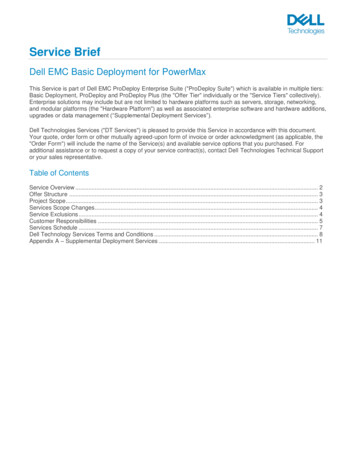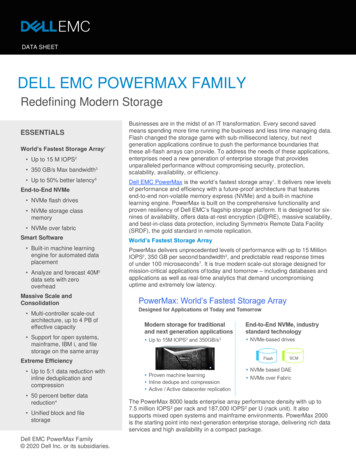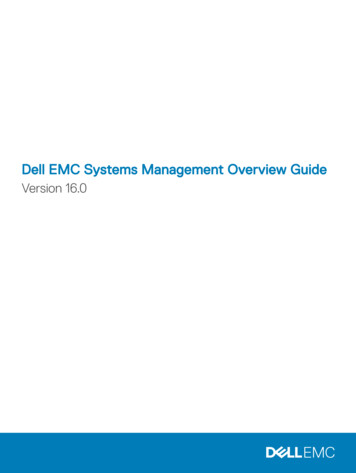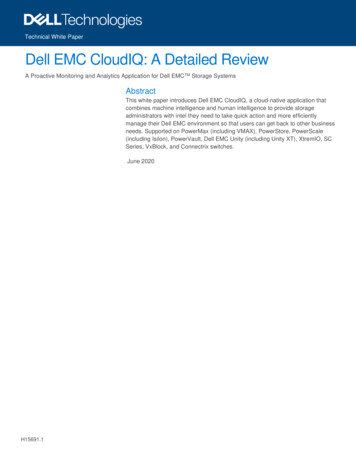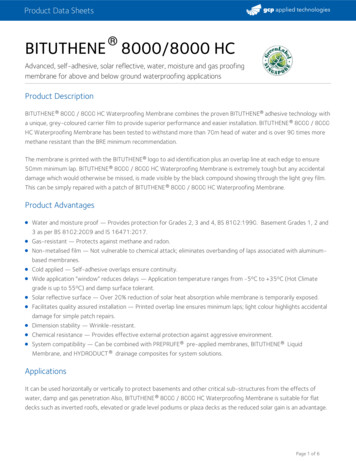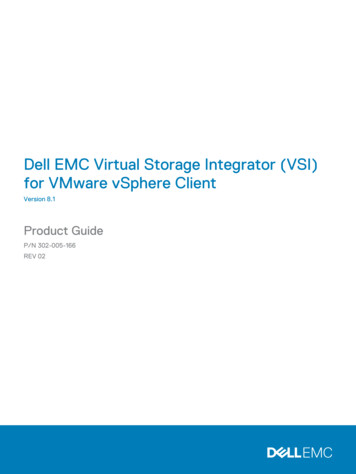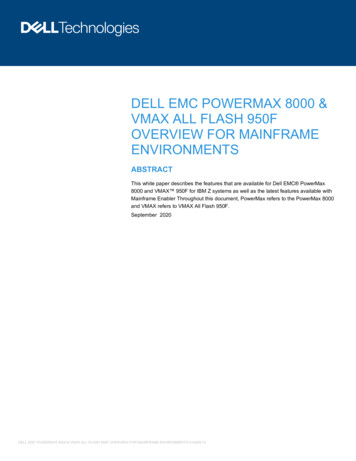
Transcription
DELL EMC POWERMAX 8000 &VMAX ALL FLASH 950FOVERVIEW FOR MAINFRAMEENVIRONMENTSABSTRACTThis white paper describes the features that are available for Dell EMC PowerMax8000 and VMAX 950F for IBM Z systems as well as the latest features available withMainframe Enabler Throughout this document, PowerMax refers to the PowerMax 8000and VMAX refers to VMAX All Flash 950F.September 2020DELL EMC POWERMAX 8000 & VMAX ALL FLASH 950F OVERVIEW FOR MAINFRAME ENVIRONMENTS H14909.10
RevisionsDateDescriptionAugust 2019Revision 0.9 which includes content related to OS 5978 SR (Q3 2019) as well asreformatting and attributions of the prior release (0.8)September 2020Revision 0.10 which includes content related to OS 5978.669.669 SR (Q3 2020) aswell as reformatting and attributions of the prior release (0.9)AcknowledgementsThis paper was produced by the following:Authors: Justin Bastin, Brett Quinn, Bruce Klenk, Paul ScheuerSupport: Dell EMC Technical Marketing, Engineering TeamThe information in this publication is provided as is. Dell Inc. makes no representations or warranties of any kind withrespect to the information in this publication and specifically disclaims implied warranties of merchantability or fitness for aparticular purpose.Use, copying, and distribution of any software described in this publication requires an applicable software license.Copyright 2020 Dell Inc. or its subsidiaries. All Rights Reserved. Dell, EMC, and other trademarks are trademarks ofDell Inc. or its subsidiaries. Other trademarks may be the property of their respective owners. September 2020. Whitepaper h14909.10DELL EMC POWERMAX 8000 & VMAX ALL FLASH 950F OVERVIEW FOR MAINFRAME ENVIRONMENTS H14909.10
TABLE OF CONTENTSEXECUTIVE SUMMARY . 4AUDIENCE . 4INTRODUCTION. 5system Overview: Powermax 8000 and VMAX 950F. 6Dynamic Virtual Matrix/Infiniband Fabric . 7PowerMax 8000 System Configurations. 8Dual Rack PowerMax 8000 Configurations . 106 Gb/s SAS back-end/drive infrastructure . 12Bay (rack) Dispersion . 13HYPERMAX OS and PowERMAXoS . 13Embedded Hypervisor . 14Virtual Provisioning . 14Data at Rest Encyption (D@RE) . 15Multi-Core Emulation: Processing Power Where it’s Needed Most . 15Vault to FLASH . 16MANAGEMENT SOFTWARE . 16Mainframe Enabler . 16GDDR – Geographically Dispersed Disaster Restart . 17IBM-Compatible Transparent Cloud Tiering (TCT) . 17Unisphere . 17TimeFinder SnapVX . 17zDPTM – Data Protector for z Systems . 18Enhanced SRDF. 1916 Gb/s FICON and zHPF support . 20IBM Z Compatibility (aka “Storage Synergy”) . 20CONCLUSION . 22DELL EMC POWERMAX 8000 & VMAX ALL FLASH 950F OVERVIEW FOR MAINFRAME ENVIRONMENTS H14909.10
EXECUTIVE SUMMARYOrganizations around the globe need IT infrastructures that can deliver instant, continuous access to themassively increasing volumes of data associated with traditional online transaction, batch processing, and bigdata use cases such as data warehousing and data analytics. This must be accomplished with a continuousreduction in total cost of ownership (TCO), improvement in storage Service Level Agreements (SLAs) andmitigation of risk associated with storing the data. Many are contractually bound to SLAs that describe requiredlevels of service, often with penalties associated with non-compliance. Organizations are trying to understandhow the new generation of ‘systems of engagement’ applications, built around the world of social, mobile, cloud,and big data (collectively named the “3rd Platform” by IDC) can be leveraged on the mainframe (known as the 1stplatform) which serves as the “system of record” for most large organizations. New threats to data availability andintegrity are surfacing almost weekly and IT organizations must respond with state-of-the-art techniques to protecttheir data. Dell EMC has been helping enterprises solve mainframe storage problems for decades and is nowredefining the traditional storage array, morphing it into a “Data Services platform” that will become the bridgebetween the 1st and 3rd platforms to modernize and deliver the next generation of Hybrid Cloud computing andstorage with the ultimate in availability, data integrity, and TCO management.Modern mainframe storage architectures require: Massive capacity scaling Massive performance scaling Flexibility to handle highly fluctuating workloads yet maintain consistent service levels, all the time Both physical and logical protection from threats to data integrity and availability A data protection infrastructure that can scale across an unlimited number of arrays, sysplexes, andphysical locations Reduced costs through infrastructure hyper-convergence A usage model that is automated and almost totally hands off, unifying management with other platformsand further reducing TCOThe mainframe-enabled PowerMax 8000 and the VMAX All Flash 950F arrays are designed to meet andexceed these requirements through: Leveraging a scale out architecture up to 8 engines, 576 cores, 16TB cache and 256 physical hostconnections Leveraging the powerful Dynamic Virtual Matrix architecture in a single storage tier. The most advanced local and remote replication solutions in the industry A converged storage platform capable of running powerful storage and application workloads onPowerMax and VMAX including Mainframe, Open, IBM i An ease of use model that is unique in the high-end storage industryThis paper explains how the PowerMax and VMAX arrays delivers these capabilities and more for mainframeenvironments.AUDIENCEThis white paper is intended for Dell EMC customers and those evaluating Dell EMC storage for purchase.DELL EMC POWERMAX 8000 & VMAX ALL FLASH 950F OVERVIEW FOR MAINFRAME ENVIRONMENTS H14909.10
INTRODUCTIONDell EMC’s PowerMax and VMAX are incredibly well positioned to solve the CIO’s challenges of embracing amodernized, flash-centric data center while simultaneously trying to simplify, automate, and consolidate IToperations. PowerMax and VMAX aren’t just bigger, better, and faster (although they are!), Both are a flexibleData Services platform that specifically addresses the new requirements of the modern mainframe data centerwhile continuing to deliver the reliability and availability our customers have relied on for years.With PowerMAX and VMAX, the industry’s leading tier 1 array has evolved into a thin-provisioned hardwareplatform with a complete set of rich software data services including Data Protector for z systems (zDP), arevolutionary new data protection solution that enables rapid recovery from logical data corruption, be it fromsimple processing errors or malicious intent. Data services are delivered by a highly resilient, agile hardwareplatform that offers global cache, CPU (processing) flexibility, performance and high availability at scale to meetthe most demanding storage requirements.These arrays radically simplify management at scale by eliminating the need for storage administrators to answerthe questions “how many disks of which type to allocate” and “where does my data need to be placed?” Tier 1storage management can now be done in a matter of minutes,and doesn’t require extensively trained IT storageadministrators.The PowerMax 8000 differentiates itself as the first Dell EMC hardware platform with a storage back-end thatuses Non-Volatile Memory Express (NVMe) and Storage Class Memory (SCM) for customer data. NVMe is a setof standards which define a PCI Express (PCIe) interface used to efficiently access storage devices based onNon-Volatile Memory (NVM) media, which includes today’s NAND-based flash along with higher-performingStorage Class Memory (SCM) media technologies such as 3D XPoint and Resistive RAM (ReRAM). The NVMebased PowerMax was specifically created to fully unlock the bandwidth, IOPS, and latency performance benefitsthat NVM media offers to host based applications which are unattainable using the current generation all flashstorage arrays.By delivering these capabilities, PowerMax and VMAX improves overall staff productivity, giving them time tofocus on the needs of the business, rather than management of the technology.Dell EMC PowerMax 8000 and VMAX All Flash 950F arrays continue the mainframe legacy of all Symmetrix,DMX, and VMAX arrays that have come before it. They enable IT departments to consolidate, economize andreduce risk within their data center infrastructure while delivering mission-critical storage with scale, performance,availability, security and agility from Dell EMC that companies have relied on for years.DELL EMC POWERMAX 8000 & VMAX ALL FLASH 950F OVERVIEW FOR MAINFRAME ENVIRONMENTS H14909.10
SYSTEM OVERVIEW: POWERMAX 8000 AND VMAX 950FFigure 1 below shows the basic building block of both the PowerMax and VMAX array is the ‘engine’. An engine isa pair of physically separate director boards housed in the same enclosure. In order to enhance availability, eachdirector board is physically independent, with its own Intel processors, power feed and redundant hardware. Thedirector board supports Intel Broadwell processors with 18 physical cores each (50% more than previous models).An eight engine PowerMax 8000 or VMAX 950F array employs 576 Intel processor cores. Since the operatingsystems of both arrays (PowerMax OS and HYPERMAX OS) exploit the SMT2 feature of the Intel processors, inreality there are up to 1152 logical processor cores deployed in an 8 engine array for a fully populated system.Figure 1 PowerMax and VMAX enginePowerMax and VMAX are built using a combination of ‘bricks’ (called V-Bricks in VMAX and PowerBricks inPowerMax) and ‘capacity packs’. Bricks are comprised of an engine and a capacity pack containing, at aminimum, 13TB of flash drive capacity. In engines configured for FICON /CKD only these are called zBricks (orzPowerbricks) and zCapacity Packs. In Q3 of 2020 the zBrick-S a single engine 1 TB or 13TB CKD-only,configurable up to 54TB was introduced.The PowerMax 8000 platform includes: 1 -8 PowerBricks / zPowerBricks per system 2 x 18 core, 2.8 GHz, Intel Broadwell CPUs yielding 72 cores per PowerBrick 1 TB, 2 TB DDR4 cache per PowerBrick Up to 256 FE ports per system (OS and MF) Up to 4 PBe capacity per system (up to1.7PBu if CKD only) of PCIe Gen3 NVMe storage in two racks Open systems and/or mainframe support 24 slot NVMe DAE using 2.5” form factor 1.92 TB, 3.84 TB, or 7.68 TB NVMe Drives Dual ported NVMe PCIe Gen3 (8 lane) backend I/O interface modules (4 per engine) delivering 8 GB/secof bandwidth per module (32 GB/sec per engine) to the NVMe / SCM storage Powerful data reduction I/O modules which perform both inline hardware data compression anddeduplication for FBA formatted disk only.The VMAX 950F platform includes: 1 - 8 V-Bricks / zBricks per system 2 x 18 core, 2.8 GHz, Intel Broadwell CPUs yielding 72 cores per engine 1 TB, 2 TB DDR4 cache per engine Up to 256 FE ports per system (MF, 192 for OS)DELL EMC POWERMAX 8000 & VMAX ALL FLASH 950F OVERVIEW FOR MAINFRAME ENVIRONMENTS H14909.10
Up to 4 PBe capacity per system using SAS-2 all-flash storageOpen Systems and/or mainframe supportTwo 4U Drive Array Enclosures (DAEs) that house up to 120 6 Gb/s SAS attached 2.5” TLC flash drivesof 960GB, 1.92TB, 3.84TB, 7.68TB, or 15.36TB with a base storage capacity, of 13 TBu.Dynamic Virtual Matrix/Infiniband FabricThe Dynamic Virtual Matrix provides the Global Memory interface between directors with more than one engine.The Dynamic Virtual Matrix is composed of multiple elements, including Infiniband Host Channel Adapter (HCA)endpoints, Infiniband Interconnects (switches), and high-speed passive, active copper, and optical serial cables toprovide a Virtual Matrix interconnect.A fabric Application Specific Integrated Circuit (ASIC) switch resides within a special Management Interface BoardEnclosure (MIBE), which is responsible for Virtual Matrix initialization and management. Each fabric port connectsback to an Infiniband switch housed in the first system bay cabinet. The Infiniband switches are only present inmulti-engine systems and are added with the addition of a second engine. Infiniband switches are installed inpairs and each director has a path to Fabric switch A and B. Fabric switches are supported by standby powersupplies for vault activities to ensure all cache data gets vaulted.PowerMax 8000 Drive Array Enclosures (DAE) and Drive ConfigurationsEach PowerBrick comes with two 24-slot, dual-ported, 2.5” PCIe NVMe DAEs (DAE24). These DAEs useredundant, hot-swappable Link Control Cards (LCCs) which provide PCIe I/O connectivity to the NVMe or SCMflash drives. Aside from redundant LCCs, the DAE24 features redundant power supplies with separate powerfeeds, providing N 1 power and cooling, resulting in an energy efficient consumption of 25 watts per drive slot.The DAE24 is 2U high and 19” deep.Figure 2 PowerMax 24 slot Drive Array EnclusurePowerMax Drive Options and Universal SparingPowerMax 8000 supports 1.92 TB, 3.84 TB, and 7.68 TB NVMe and 750GB or 1.5TB SCM flash drive capacities.All the drive sizes are 2.5” and feature a dual ported U.2 form factor PCIe interface. These drive capacities can beintermixed on the system. PowerMax uses universal sparing: systems with mixed drive configurations can use asingle spare drive with the largest capacity size in the system. For example, if a system uses both 3.84 TB and7.68 TB drives in the configuration, only one 7.68 TB drive needs to be configured as a spare, because it canreplace either the 3.84 TB or 7.68 TB drives.Figure 3 Universal Sparing ExampleDELL EMC POWERMAX 8000 & VMAX ALL FLASH 950F OVERVIEW FOR MAINFRAME ENVIRONMENTS H14909.10
The Universal Spare can be also used in mixed systems with multiple storage resource pools (SRP). Forexample, if the mixed system uses 7.68 TB drives for the FBA SRP and 3.84 TB drives for the CKD SRP, thesystem will still only need a single 7.68 TB drive spare.There are some rules for mixing drive capacities and universal sparing on PowerMax: There can be only two drive size types on the system and the drive sizes need to be onesequential drive size apart. For example, the system can have a mix of 1.92 TB and 3.84 TBdrives, but not 1.92 TB and 7.68 TB sizes. On mixed systems, drive mixing rules apply only with the individual SRPs. For example, theCKD SRP can have 1.92 TB and 3.84 TB drives, while the FBA SRP can have 3.84 TB and7.68 TB drives. In this case, both SRPs would require a unique spare. The CKD SRP coulduse a single 3.84 TB spare, while the FBA SRP could use a single 7.68 TB spare. A single7.68 TB drive could not be used as a universal spare for both the CKD and FBA SRPs in thiscase because it is beyond one drive size apart from the 1.92 TB drives in the CKD SRP.PowerMax Smart RAIDPowerMax uses a new active/active RAID group accessing scheme called Smart RAID. This allows RAID groupsto be shared across directors, giving each director active access to all drives on the PowerBrick or zPowerBrick.Figure 4 PowerMax Smart RAIDThe use of Smart RAID on PowerMax provides customers with performance benefits as both directors on anengine can drive I/O to all the flash drives. This creates balanced configurations in the system regardless of thenumber of RAID groups. Smart RAID also allows for increased flexibility and efficiency as customers can orderPowerMax systems with a single RAID group allowing for a minimum of 9 drives per engine with RAID 5 (7 1) orRAID 6 (6 2 and 1 spare). This leaves more drive slots available for capacity upgrades in the future. When thesystem is scaled up, customers have more flexibility because flash capacity pack increments can be a singleRAID group.PowerMax 8000 System ConfigurationsPowerMax 8000 is the flagship of the PowerMax family and provides Dell EMC customers with unmatchedscalability, performance, and IOPS density. It can consolidate disparate workloads on a mass scale as 8PowerBricks can support over 10 million IOPS (8K RRH) and provide up to 4 PB of effective capacity in just twofloor tiles of space.DELL EMC POWERMAX 8000 & VMAX ALL FLASH 950F OVERVIEW FOR MAINFRAME ENVIRONMENTS H14909.10
The PowerMax 8000 is a highly configurable data storage array as it can support configurations from 1 to 8PowerBricks within two standard Dell EMC Titan racks. Each rack can support up to four PowerBricks.PowerBricks 1 – 4 always occupy a single rack. PowerMax 8000 only requires a second rack when thePowerBrick count is greater than four.The figure below shows a single rack PowerMaxFigure 5 PowerMax 8000 single and dual PowerBrick configurationsThe PowerMax 8000 uses redundant 16 port Dell X1018 Ethernet Switches for the internal management network.This network connects to every engine and to the two internal InfiniBand fabric switches. The InfiniBand switchesare required when two or more PowerBricks are configured in the system. The redundant 18 port InfiniBand fabricswitches connect to every director in the system.DAE 3 is added with the second PowerBrick. As mentioned earlier in the document, DAE 2 is shared byPowerBrick 1 and PowerBrick 2. In DAE 2, drive Slots 1 – 14 are used by PowerBrick 1 while slots 15 – 24 areused by PowerBrick 2. A PowerMax 8000 configuration rule of thumb is that every even numbered PowerBrickshares a DAE with the previous odd-numbered PowerBrick.Note: The PowerMax 8000 supports the use of third-party racking. The third-party rack must be astandard NEMA 19-inch rack and meet Dell EMC standards for power, cable access, and cooling. Formore information about PowerMax 8000 third-party racking options please see the Dell EMC PowerMaxFamily Site Planning GuideThe following diagram shows a three and four PowerBrick configuration for the PowerMax 8000:DELL EMC POWERMAX 8000 & VMAX ALL FLASH 950F OVERVIEW FOR MAINFRAME ENVIRONMENTS H14909.10
Figure 6 PowerMax 8000 Three and Four PowerBrick ConfigurationsDual Rack PowerMax 8000 ConfigurationsPowerMax 8000 systems that have more than four engines require a second rack (system bay). PowerBricks areadded to the second rack in the same manner and order as PowerBricks 1 – 4 are added in the first rack. Theengines for the PowerBricks in the second rack are connected to the Dell X1018 Ethernet management switches.The PowerBrick engine directors in the second rack are cabled to the InfiniBand switches in the first rack also. Noadditional InfiniBand or Dell X1018 switches are required for the second rack.The PowerMax 8000 supports rack 2 dispersion configurations of up to 82 feet (25 meters) from the fabricswitches in rack 1. Dispersed configurations require optical connections between the InfiniBand switches in rack 1and the PowerBrick engine directors in rack 2. Adjacent rack configurations can use Copper for connectionsbetween the PowerBrick engines in rack 2 and the InfiniBand switches in rack 1.The following diagrams show the various PowerMax 8000 two-rack configurations:DELL EMC POWERMAX 8000 & VMAX ALL FLASH 950F OVERVIEW FOR MAINFRAME ENVIRONMENTS H14909.10
Figure 7 PowerMax 8000 Five and Six PowerBrick ConfigurationsFigure 8 PowerMax 8000 Seven and Eight PowerBrick ConfigurtionsVMAX All Flash 950F Drive Array Enclosures (DAE) and Drive ConfigurationsVMAX 950F systems provide an ultra-high density DAE supporting up to 120 2.5” drives each. Figure 7 shows theDAE.DAEs can be added to systems in single increments if using RAID 1, RAID 5 (3 1), and RAID 6 (6 2). However, ifa system contains RAID 5 (7 1) or RAID 6 (14 2), adding DAEs may only be possible in pairs. A VMAX engine isable to support up to 6 DAEs (720 x 2.5” drives).When the system is configured at the factory, drives are distributed across engines in balanced configurations toprovide the optimal performance in the array. When drives are added it is expected that they will also be added ina balanced manner.DELL EMC POWERMAX 8000 & VMAX ALL FLASH 950F OVERVIEW FOR MAINFRAME ENVIRONMENTS H14909.10
Every DAE has 4 power zones and can thus continue to operate despite the loss of power to any one zone (whichwould require loss of two separate power supplies, also known as a double fault). If required, it is possible toconfigure RAID 6 (14 2) and RAID 5 (7 1) across 4 DAE so that only one member resides in any power zone.Figure 9 DEA 120 Drive EnclosureLocal RAID: Performance and Physical Configuration BenefitsVMAX arrays implement local RAID which requires all members of a RAID group to be associated with the sameengine. This ensures local access and control over I/O for all RAID members and reduces the number ofmessages and Global Memory operations that need to be carried out for RAID operations, lowering I/O overheadand improving RAID performance.Local RAID also eliminates the need for cross-bay (cross-frame) cabling in direct/daisy chain DAEs. This allowsfor the physical separation of a multiple frame VMAX system at the engine/bay level (in order to position theframes around any obstacles or across an aisle in the datacenter), making the VMAX systems the most flexiblestorage system in the industry.6 Gb/s SAS back-end/drive infrastructureAll VMAX 950F models utilize 6 Gb/s SAS (Serial Attached SCSI) drives with a “back-end” configuration thatprovides improved performance over legacy architectures. SAS is a high-speed, extremely reliable protocol thatuses the same low-level technology as Fibre Channel encoding. SAS topology is different from Fibre Channel asSAS uses a connectionless tree structure with unique paths to individual devices. Routing tables store thesepaths and help to route I/O to the required locations.Dense Single Cabinet ConfigurationsAll VMAX 950F arrays can be configured with a single engine per cabinet and up to 6 DAEs. Alternatively, andmost commonly for mainframe configurations, a system can be configured to have 2 engines per system bay with4 DAEs (up to 480 2.5” drives) to provide a much denser storage configuration, up to 4.42 PBe. A single bay canDELL EMC POWERMAX 8000 & VMAX ALL FLASH 950F OVERVIEW FOR MAINFRAME ENVIRONMENTS H14909.10
support 64 host ports and up to 4TB of cache in a single standard floor tile. Figure 8 shows the layout of the singleengine and dense configuration.Figure 10 VMAX 950F Single and Dual Engine ConfigurationNote: The VMAX 950F supports the use of third-party racking. All VMAX arrays support industry-standard19-inch racks and optional third-party racking for ease in conforming to your existing data centerinfrastructure. Third Party racks must meet the dimensions set out in the Dell EMC VMAX All Flash SitePlanning Guide available on https://support.emc.comBay (rack) DispersionBoth the VMAX 950F and PowerMax 8000 racks can be physically separated by up to 25 meters to avoidcolumns and other obstacles in the data center without a need to reserve empty floor tiles for future array growth.Any VMAX or PowerMax system bay can be placed anywhere in your data center as long as it is within 82 feet(25 meters) of the first system bay which houses the Infiniband Dynamic Virtual Matrix switches. Figure 9 shows apossible dispersion (separation) option for an 8-engine VMAX 950 with 2 adjacent system bays and 6 systembays dispersed at a distance of 25M each from system bay 1.Figure 11 VMAX and PowerMax Bay DispersionHYPERMAX OS AND POWERMAXOSThe internal operating system that controls the array’s resources and data services is called HYPERMAX OS inthe VMAX 950F and POWERMAX OS in the PowerMax 8000. These operating systems combine industryleading high availability, I/O management, Quality of Service (QoS), data integrity validation, storage tiering, anddata security with the first real-time, non-disruptive storage hypervisor that manages and protects embeddedservices. The hypervisor can be non-disruptively upgraded on all engines in the array.DELL EMC POWERMAX 8000 & VMAX ALL FLASH 950F OVERVIEW FOR MAINFRAME ENVIRONMENTS H14909.10
These hypervisors reduce external hardware and networking requirements, deliver higher levels of availability,and dramatically lowers latency. HYPERMAX OS and PowerMaxOS run the 56Gb/sec Infiniband based DynamicVirtual Matrix which provides redundant interconnectivity to all engines in the array leveraging the scale-outflexibility of cores, cache, and host interfaces.HYPERMAX OS and PowerMaxOS provide: Virtual provisioning infrastructure with a capacity allocation granularity of a single track, the smallest in theindustry The management of system resources to intelligently optimize performance across a wide range of I/Orequirements and ensure system availability through advanced fault monitoring, detection, and correctioncapabilities Concurrent maintenance and serviceability features The foundation for specific software features available through Dell EMC’s disaster recovery, businesscontinuity, and storage management software Functional services for VMAX and PowerMax arrays and for a large suite of Dell EMC storage applicationsoftware Automated task prioritization, including basic system maintenance, I/O processing, and applicationprocessingEmbedded HypervisorHYPERMAX OS derived its name from the inclusion of a hypervisor which enables embedded data services toexecute directly on the storage array delivering new levels of efficiency to enterprise workloads. PowerMaxOSalso includes a hypervisor. This guest operating system environment is currently used to provide these services:1. Monitoring and control of a single VMAX or PowerMax via a ‘tools’ guest hosting Solutions Enabler andUnisphere for array management and performance monitoring2. The analytics components of Fully Automated Storage Tiering pattern recognition as well as host-provided hinttranslation services. This component is used by a number of internal technologies to determine the priority of atransaction.3. Embedded NAS (eNAS) which provides flexible and secure multi-protocol file sharing (NFS, CIFS/SMB 3.0) aswell as multiple file server identities (CIFS and NFS servers)Virtual ProvisioningAll VMAX 950F and PowerMax arrays arrive pre-configured from the factory with Virtual Provisioning Pools readyfor use. VMAX and PowerMax pool all drives into a Storage Resource Pool (SRP) which provides physicalstorage for thin devices that are presented to hosts, and require no initial setup by the storage administrator,reducing the time to I/O and radically simplifying the management of the array. With the SRP, capacity ismonitored at the SRP level and disk pools, RAID levels, and thin device (TDEV) binding to storage pools are nolonger constructs the storage administrator needs to manage. All thin devices are ready for use upon creationand RAID is implemented under the covers in the SRP as part of the pre-configuration. The figure below showsthe SRP components and the relationship to the storage group (SG) used for grouping thin devices to the hostapplications. Note there is a 1:1 relationship between disk groups and data pools. Each disk groups specifies aRAID protection and disk size forming the basis for each of the preconfigured thin pools. Every VMAX andPowerMax array comes from the factory with the configuration file (bin file) already created. This means bestDELL EMC POWERMAX 8000 & VMAX ALL FLASH 950F OVERVIEW FOR MAINFRAME ENVIRONMENTS H14909.10
practices for deployment - TDAT sizes, RAID protection, and data pools - will already be in place and no longerhave to be created or managed by the storage administrator.Figure 12 Virtual Provisioning in VMAX and PowerMaxVMAX and PowerMax arrays support 3380 and 3390 CKD volumes using a single 56KB track size as theallocation unit for storage from SRPs for thin provisioned devices. When thin devices are created in a VMAX orPowerMax array they consume no space from the SRP until they are first written. Space reclamation isperformed periodically via a Dell EMC z/OS based batch utility.Data at Rest Encyption (D@RE)Data in enterprise storage must be secure, both inside and outside of the VMAX or PowerMax. D@RE (Data atRes
and big data (collectively named the "3rd Platform" by IDC) can be leveraged on the mainframe (known as the 1st . morphing it into a "Data Services platform" that will become the bridge between the 1. st. . PowerMax and VMAX including Mainframe, Open, IBM i An ease of use model that is unique in the high-end storage industry
